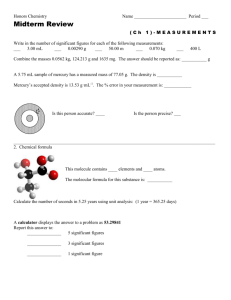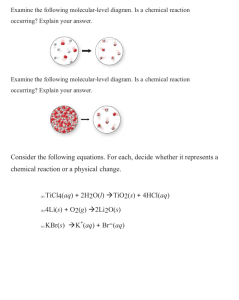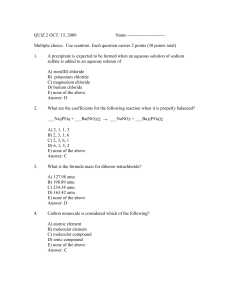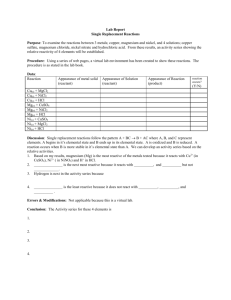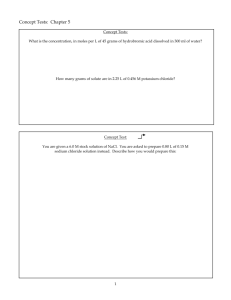Net Ionic Equations - Seattle Central College
advertisement
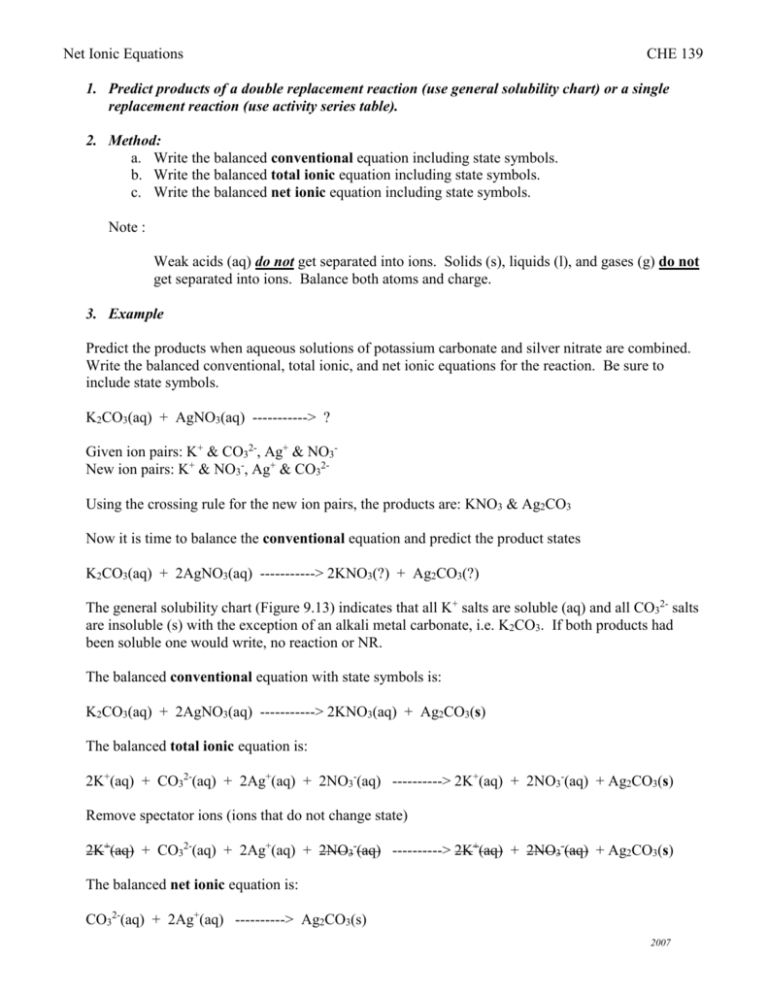
Net Ionic Equations CHE 139 1. Predict products of a double replacement reaction (use general solubility chart) or a single replacement reaction (use activity series table). 2. Method: a. Write the balanced conventional equation including state symbols. b. Write the balanced total ionic equation including state symbols. c. Write the balanced net ionic equation including state symbols. Note : Weak acids (aq) do not get separated into ions. Solids (s), liquids (l), and gases (g) do not get separated into ions. Balance both atoms and charge. 3. Example Predict the products when aqueous solutions of potassium carbonate and silver nitrate are combined. Write the balanced conventional, total ionic, and net ionic equations for the reaction. Be sure to include state symbols. K2CO3(aq) + AgNO3(aq) -----------> ? Given ion pairs: K+ & CO32-, Ag+ & NO3New ion pairs: K+ & NO3-, Ag+ & CO32Using the crossing rule for the new ion pairs, the products are: KNO3 & Ag2CO3 Now it is time to balance the conventional equation and predict the product states K2CO3(aq) + 2AgNO3(aq) -----------> 2KNO3(?) + Ag2CO3(?) The general solubility chart (Figure 9.13) indicates that all K+ salts are soluble (aq) and all CO32- salts are insoluble (s) with the exception of an alkali metal carbonate, i.e. K2CO3. If both products had been soluble one would write, no reaction or NR. The balanced conventional equation with state symbols is: K2CO3(aq) + 2AgNO3(aq) -----------> 2KNO3(aq) + Ag2CO3(s) The balanced total ionic equation is: 2K+(aq) + CO32-(aq) + 2Ag+(aq) + 2NO3-(aq) ----------> 2K+(aq) + 2NO3-(aq) + Ag2CO3(s) Remove spectator ions (ions that do not change state) 2K+(aq) + CO32-(aq) + 2Ag+(aq) + 2NO3-(aq) ----------> 2K+(aq) + 2NO3-(aq) + Ag2CO3(s) The balanced net ionic equation is: CO32-(aq) + 2Ag+(aq) ----------> Ag2CO3(s) 2007 More Examples of net ionic double replacement equations: KCH3COO(aq) + HCl(aq) ------------> ? KCH3COO(aq) + HCl(aq) ------------> KCl(aq) + CH3COOH(aq) strong acid weak acid K+(aq) + CH3COO-(aq) + H+(aq) + Cl-(aq) ---------> K+(aq) + Cl-(aq) + CH3COOH(aq) CH3COO-(aq) + H+(aq) ---------> CH3COOH(aq) KOH(aq) + HCl(aq) ------------> ? KOH(aq) + HCl(aq) ------------> KCl(aq) + H2O(l) strong base strong acid salt water K+(aq) + OH-(aq) + H+(aq) + Cl-(aq) ---------> K+(aq) + Cl-(aq) + H2O(l) OH-(aq) + H+(aq) ---------> H2O(l) K2CO3(aq) + HCl(aq) ------------> ? K2CO3(aq) + 2HCl(aq) ------------> 2KCl(aq) + H2CO3(aq) --------> 2KCl(aq) + H2O(l) + CO2(g) carbonate base strong acid weak acid, unstable salt water 2K+(aq) + CO32-(aq) + 2H+(aq) + 2Cl-(aq) ----------> 2K+(aq) + 2Cl-(aq) + H2O(l) + CO2(g) CO32-(aq) + 2H+(aq) ----------> H2O(l) + CO2(g) CaCl2(s) + FeSO4(aq) ------------> ? CaCl2(s) + FeSO4(aq) ------------> CaSO4(s) + FeCl2(aq) CaCl2(s) + Fe2+(aq) + SO42-(aq) ----------> CaSO4(s) + Fe2+(aq) + 2Cl-(aq) CaCl2(s) + SO42-(aq) ----------> CaSO4(s) + 2Cl-(aq) 2007 Examples of net ionic single replacement equations: Fe(s) + Cu(NO3)2(aq) ----------> ? Fe is above Cu on the activity series table. Thus Fe solid will replace Cu in solution. Fe(s) + Cu(NO3)2(aq) ----------> Fe(NO3)2(aq) + Cu(s) Fe(s) + Cu2+(aq) + 2NO3-(aq) ----------> Fe2+(aq) + 2NO3-(aq) + Cu(s) Fe(s) + Cu2+(aq) ----------> Fe2+(aq) + Cu(s) Ni(s) + HCl(aq) ----------> ? Ni is above H2 on the activity series table. Thus Ni solid will replace H+ in solution. Ni(s) + 2HCl(aq) ----------> NiCl2(aq) + H2(g) Ni(s) + 2H+(aq) + 2Cl-(aq) ----------> Ni2+(aq) + 2Cl-(aq) + H2(g) Ni(s) + 2H+(aq) ----------> Ni2+(aq) + H2(g) Ag(s) + Cu(NO3)2(aq) -----------> ? Ag is below Cu on the activity series table. Thus Ag solid will not replace Cu in solution. Ag(s) + Cu(NO3)2(aq) -----------> NR Ca(s) + H2O(l) ----------> ? Ca is above H2 on the activity series table. Thus Ca solid will replace “H+” in water. This is typical behavior of the alkali and alkaline earth metals only. Ca(s) + 2H2O(l) ----------> Ca(OH)2(s) + H2(g) 2007
